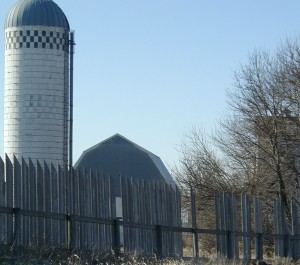Tag: antibiotic resistance’
Under Pressure: Antibiotics and Adaptation
- by KitchenPantryScientist
For centuries, people have harvested corn by hacking it off, six to fifteen inches above the ground. A caterpillar called the corn borer appears to have adapted its behavior to the corn harvest by travelling back down the stalk to a safe height, before spinning its cocoon. This week, the Science Times reported on a study that suggests that, by descending to the bottom of the stalks, the bugs avoid being chopped off when the corn is harvested. Researchers at McGill University think that “over generations, those caterpillars that did not descend, or did not go down far enough, did not survive.” In the article, Dr. Calcagno suggests that the likeliest explanation for this behavior is the selection pressure of harvesting over generations. In other words, only the caterpillars that crawled down survived to reproduce and make baby bugs, until only caterpillars with the family trait of crawling down remained in the population.
Similar forces are at work on bacteria that live in animals and humans, only instead adapting to harvest, they’re adapting to constant exposure to antibiotics. As a result, many harmful bacteria are finding ways to “outsmart” antibiotics. This is, in part, due to the mind-boggling volume of these drugs fed to animals produced for food. I can’t give you a number, because according to the Center for Disease Control’s website, the amount of antibiotics fed to farm animals is not available to the public or to government agencies.
Feeding animals antibiotics helps them grow. No one knows exactly why. Unfortunately, using these drugs as growth enhancers, or even to protect them from disease, often creates antibiotic-resistant strains of bacteria that have the potential to end up in our food supply. These drug-resistant pathogens are especially dangerous to people who live and work on farms ( just ask Russ Kremer, who was gored by one of his hogs and nearly died from an antibiotic-resistant infection.) In reponse to the global threat presented by antibiotic resistance, the World Health Organization recommended that antibiotics used in humans should not be used to promote growth in food animals.
Healthy animals occasionally need to be treated for infections, but feeding animals antibiotics for growth benefits is a risk no one should be taking. A huge amount of money is spent each year on these drugs so producers can get top dollar for their animals. My worry is that the additional costs to public health are not being considered, especially if our pharmaceutical arsenal is rendered useless by this practice.
Want to learn more? You can check out the CDC’s website for a wealth of information on antibiotic resistance. Their program “Get Smart on the Farm” promotes appropriate antibiotic use in animals.
FRESH
- by KitchenPantryScientist
 Happy Earth Day! This weekend, we planted a garden. Few things make me happier than watching my kids digging in the dirt, planting things. Maybe it’s because I come from a long line of farmers, or maybe it’s the sun-warmed, homegrown tomato I can almost taste just by thinking about it.
Happy Earth Day! This weekend, we planted a garden. Few things make me happier than watching my kids digging in the dirt, planting things. Maybe it’s because I come from a long line of farmers, or maybe it’s the sun-warmed, homegrown tomato I can almost taste just by thinking about it.
One of the most interesting books I’ve read recently is Michael Pollan’s “Omnivore’s Dilemma,” which follows four meals from field to table (from McDonald’s to foraging for mushrooms and hunting a wild boar.) It reminds the reader of how disconnected we have become from the sources of our food. One of my favorite parts of the book talks about Joel Saletin, who is a seminal figure in the sustainable agriculture movement and probably the most famous farmer in America. His bio on the FRESH movie website says:
“Joel calls himself a grass-farmer, for it is the grass that transforms the sun into energy that his animals can then feed on. By closely observing nature, Joel created a rotational grazing system that not only allows the land to heal but also allows the animals to behave the way the were meant to – as in expressing their “chicken-ness” or “pig-ness”, as Joel would say.”
This week, Joel is in town with Ana Joanes, who has made a documentary called “FRESH” that celebrates the farmers, thinkers and business people across America who are re-inventing our food system. It’s about food, but it’s also about economics, community and social justice. Last weekend, I was lucky enough to meet both Ana and Joel while volunteering at one of Joel’s lectures and was impressed with their optimism and sense of humor. Ana recently told planetgreen.discovery.com “I just had a little girl. Her name is Maayan. And, as clichéd as it may sound, I just want to do right by her. I don’t know what reality she’ll face when she reaches adulthood, but I’m trying my best so she doesn’t have to pick up the pieces of our recklessness and inaction.”
I saw FRESH last night in Minneapolis and loved it! The movie is just 70 minutes long, but you will want to talk about it for two hours afterwards! Tonight’s the last night it’s showing, so if you’re in the Twin Cities, don’t miss it! You can order tickets here.
The movie brings up interesting points about monocultures, antibiotic resistance, high fructose corn syrup, the corn industry (which my grandparents’ farm in Iowa is a part of,) and beneficial bacteria. I’m planning to explore many of these issues on this blog by writing a weekly post about food science between science experiments! Stay tuned!


